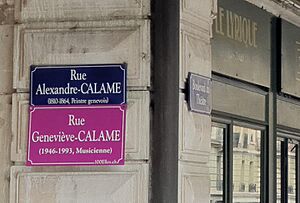Geneviève Calame facts for kids
Geneviève Calame (born December 30, 1946 – died October 8, 1993) was a talented Swiss musician. She was a pianist, a music teacher, and a composer. She created many different kinds of music, including electronic music and multimedia art.
Contents
Early Life and Education
Geneviève Calame was born in Geneva, Switzerland. Her family had roots in Greece and Italy. She started her music journey by studying piano in Geneva with Lottie Morel. Later, she continued her piano studies in Rome with Guido Agosti.
She kept learning in Geneva with Louis Hiltbrand and Jacques Guyonnet. Geneviève also took special courses in composing music. She studied in London with Pierre Boulez, in Liège with Henri Pousseur, and in Paris with Jean-Claude Eloy.
Geneviève was also interested in new technologies. She learned about electronic and electro-acoustic technology in New York City. Her teachers there were Hubert Howe and visual artist Bill Etra. From 1972 to 1983, she often performed as a piano soloist. She played in the Studio de Musique Contemporaine, which focuses on modern music.
Career and Innovations
After finishing her studies, Geneviève Calame became a composer. She worked in contemporary music studios in Geneva. In 1971, she and Jacques Guyonnet started a special studio. It was called A.R.T. (Artistic Research Team). This studio focused on electronic music, video, and computer technology. Here, Geneviève began to create amazing audio-visual art.
In 1972, Geneviève married Jacques Guyonnet. They had two children together.
Teaching Electronic Music
Geneviève Calame loved to share her knowledge. She created a special way to teach electronic music to children. From 1975 to 1993, she taught at the Geneva's Board of Education. She also taught at l'Ecole Supérieure d'Art Visuel in Geneva.
Leadership in Music and Art
In 1976, Geneviève became the president of the Geneva section of the International Society of Contemporary Music. This group supports new and modern music.
She was also a leader in Video Art. She made more than a hundred "paintings" from video still frames. Her video art was shown in many places around the world. These included Cannes at MIP TV, the A.R.T. Studios in Geneva, and the Museum of Fine Arts in Lausanne. Her work was also displayed in Rio de Janeiro and the Serpentine Gallery in London.
Geneviève Calame passed away in Tijuana, Mexico, in 1993.
Selected Musical Works
Geneviève Calame composed music for many different instruments and performances. Her works include pieces for orchestras, small groups of instruments (chamber ensembles), voices, and ballets. She also created electronic and multimedia performances.
Here are some of her notable works:
- L'Oiseau du matin (1972) – an electronic ballet
- Mantiq-al-Tayr (1973) – for flute, contrabass flute, and four electronic sound sources
- Différentielle verticale (1974) – for a soprano singer and a full orchestra
- Lude (1975) – for a solo harp
- Iral (1975) – for four trumpets and four trombones
- Geometry I, II, III (1975–1976) – a videotape art piece
- Le chant remémoré (1975) – a videotape art piece
- Alpha futur (1976) – for a full orchestra and a soprano singer
- Labyrinthes Fluides (1976) – a videotape art piece
- Tableaux video (1976–1977) – video paintings
- Videocosme (1976) – a videotape created for an electronic poem by Edgar Varèse
- StEpHAnE mAllArmE (1977) or Un coup de dés jamais n'abolira le hasard... – for a chamber orchestra
- Et l'Oeil rêve... (1977) – a visual poem
- Les Aubes d'Onomadore (1978) – for African instruments and a full orchestra
- Le Son-Qui-Fut-Mille (1978) – for four electronic sound sources and percussion instruments
- Mandala (1978) – for seven trumpets or seven female voices
- L'Homme-Miroir (1979) – for wind orchestra, percussion, and four electronic sound sources
- Je lui dis... (1980) – for a chamber orchestra
- Oniria (1981) – for solo piano and electronic tape
- Calligrammes (1983–1984) – for harp and chamber orchestra
- Océanides (1986) – for a chamber orchestra
- Swing (1986) – for piano
- Sur la margelle du monde (1987) – for a chamber orchestra
- Le Livre de Tchen (1988) – for three percussionists and a mime artist
- Vent solaire (1989–1990) – for shakuhachi (a Japanese flute) and orchestra
- Incantation (1989) – for organ
- Cantilène (1990) – for solo violin
- Dragon de lumière (1991) – for three wind instruments and five string instruments
- Le chant des sables (1992) – for violoncello, harp, and gongs
- Echo (1992) – for flute
- Hi Summer (1993) – for voice, harp, percussion, and synthesizer


